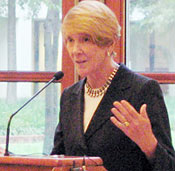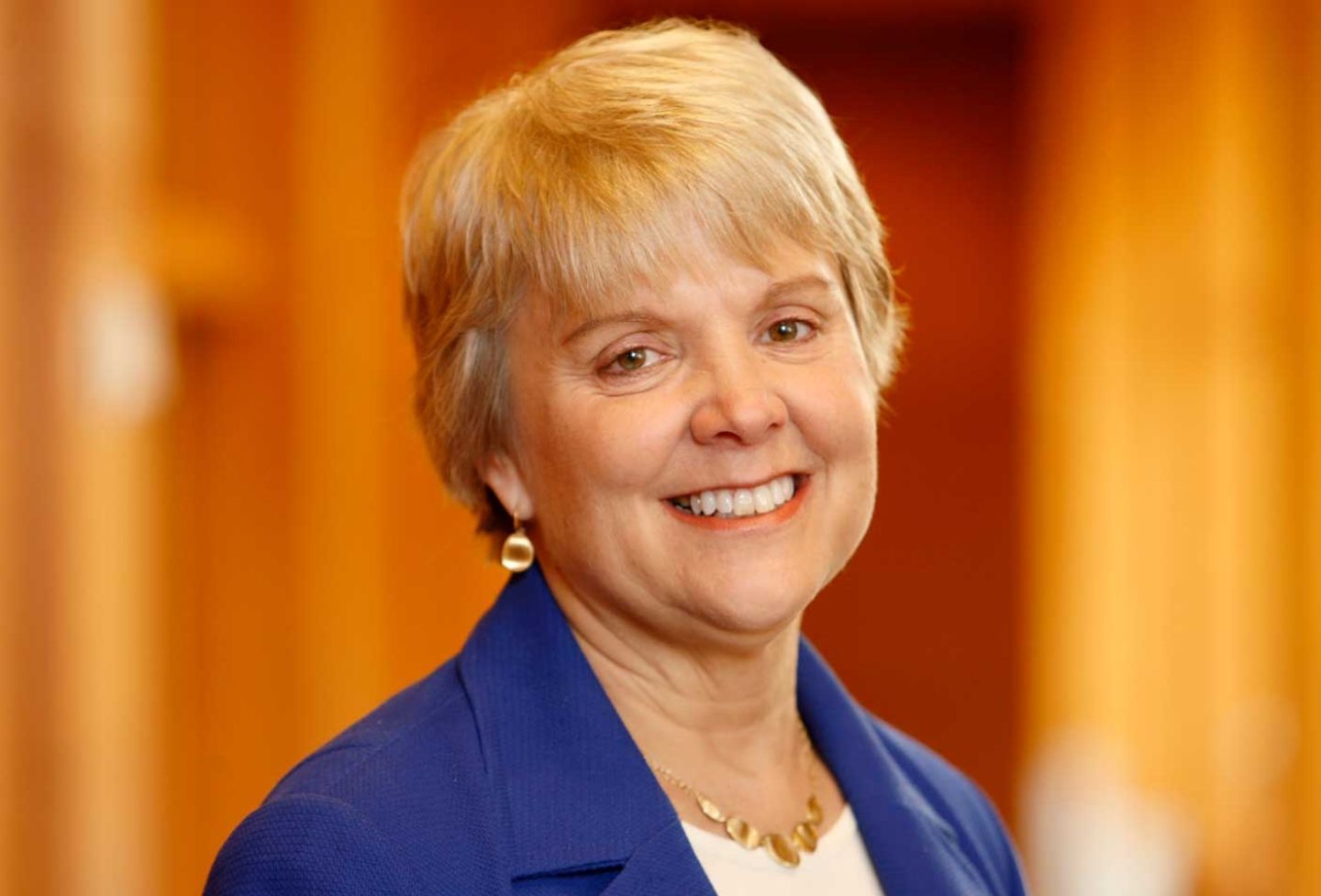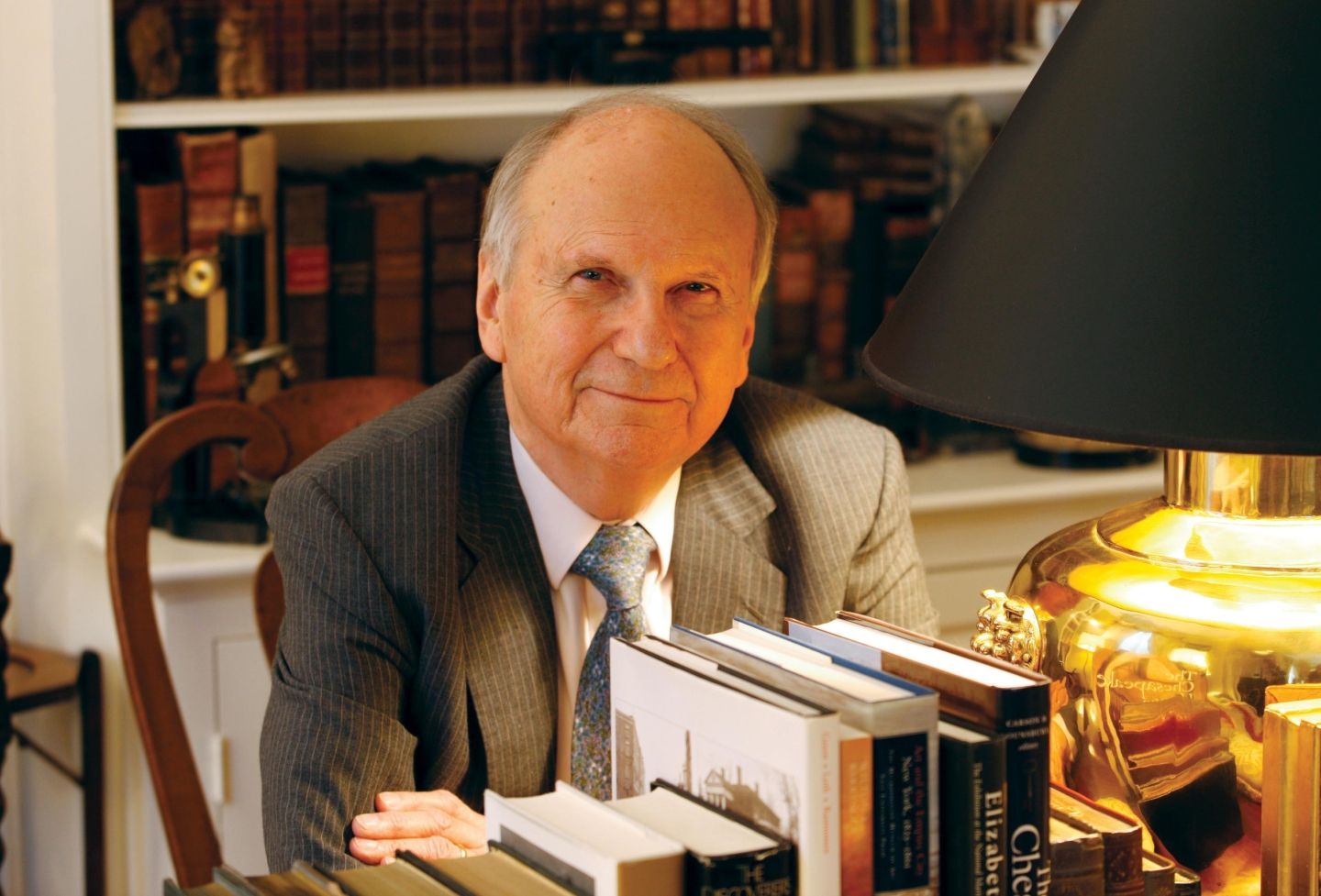Supreme Court Still Divided, Professors Say

Despite two new members, including a new chief justice, the Supreme Court is still sharply divided on several key issues, said professors at the annual review of the Court’s term Sept. 13. Professors A. E. Dick Howard, Lillian BeVier, Brandon Garrett, and John Harrison covered cases on political redistricting, free speech, criminal law, administrative law, and national security at the event, which was sponsored by the Student Legal Forum.
In his introduction, Howard reviewed the impact of former Chief Justice William Rehnquist, whom he characterized as fulfilling the promise of a conservative swing back from the liberal Earl Warren Court that the intervening chief justice, Warren Burger (1969-1986), did not satisfy. During Rehnquist’s years as chief justice, from 1986 to 2005, “a great deal of movement took place,” both in personnel—no one judge from the Warren Court remained by 2005—and in doctrinal development, with the blossoming of federalism.
“There were other developments—the so-called wall between church and state saw a good deal of erosion during the Rehnquist years; school desegregation cases began to move towards relieving school districts from federal court supervision—so there were a number of conservative fingerprints on the work of the Rehnquist court,” Howard said. “But alongside those conservative developments there was evidence of continuing vitality and a fair amount of prior doctrine that might have been thought to be endangered.”
Howard pointed to the flourishing of substantive due process in cases like Lawrence v. Texas, which ruled sodomy laws aimed at gays were unconstitutional, and to cruel and unusual punishment, which continued to be an “evolving” concept, with cases further limiting state powers in carrying out the death penalty. Justices also debated the methodology of analyzing cases, with the rise of originalism.
“There was in one sense a conservative majority, but it was not a majority made up of conservatives, all of whom were of the same mindset,” he said. With Justice Sandra Day O’Connor gone, Justice Anthony Kennedy has moved into the swing-centrist position, said Howard.
But Howard questioned whether the Rehnquist Court would be remembered as a self-confident and aggressive court, as the Warren Court is. The Rehnquist Court showed its own form of judicial activism, but in the last few years “there have been more opinions, it seems to me, in which the Court has avoided a constitutional question or decided a case somewhat narrowly or left more questions to be decided by a lower court or the like.” Howard pointed to the pledge of allegiance case that the Court tossed back to the Ninth Circuit, saying that the plaintiff didn’t have standing to sue on behalf of his child.
In the case that may have led to U.S. Rep. Tom Delay’s downfall, League of United Latin American Citizens v. Perry (combined with other cases),Howard said the Court was not sympathetic to challengers of Texas’s Republican-authored redistricting plan. They decided 5-4 that the plan was legal and that redistricting according to partisanship was constitutional.
The origins of the case are now well-known, since Delay, who announced his resignation earlier in the year amid charges of money laundering and campaign finance violations, master-minded the redistricting. In 2002 a federal court ordered Texas legislators to redraw districts, when Republicans controlled the state Senate and Democrats controlled the House. An election gave Republicans the edge in the House by 2003, and their subsequent plan caused Democrats to lose six seats.
The Supreme Court agreed that the creation of one district, in Laredo, violated the Voting Rights Act because it discriminated against Mexican-Americans. Only justices John Paul Stevens and Stephen Breyer wanted to strike down the redistricting entirely, Howard said, and when push came to shove, Roberts and Justice Samuel Alito stopped barely shy of their more conservative colleagues, Antonin Scalia and Clarence Thomas, who said partisan-based redistricting is a political, nonjusticiable question. Kennedy conceded that the redistricting was motivated by partisanship, but saw no workable test to apply to all cases. Justices David Souter and Ruth Bader Ginsburg saw no reason to debate the merits of the case given the deadlock in the court, Howard said.
“What a contrast the Texas case is with the Warren Court’s one-person, one-vote decisions,” he said. “Consider the willingness back in the ’60s of the Court to overturn the traditional notion that reapportionment questions were in the technical sense political questions.
“My personal take on this is one of discomfort,” he said, noting that most people live in districts gerrymandered to be effectively noncompetitive. Only Iowa and Arizona have independent bodies draw districts. He expressed disappointment, since “it seems to me that [gerrymandering] is as effective a disenfranchisement as if the one-person, one-vote rule were not being applied in the first place.” The U.S. Senate has remained the most competitive institution “because you can’t gerrymander a whole state.”
BeVier said the Court showed surprising unanimity in its first free speech case, then followed up with two cases that showed the justices would continue to muddy the waters on the First Amendment. In Rumsfeld v. Fair, elite law schools challenged the Solomon Amendment, which required universities accepting federal funding to allow recruiters on campus—any part of the campus, including the law schools that did not receive the funding and that protested the military’s policies toward gays.
“The Court decided that the Solomon Amendment was not unconstitutional,” said BeVier. “The result was not particularly unexpected….[but] what it seemed perhaps to signal was a court that had gotten its act together and that they were all going to be on the same page now,” she said.
Roberts’s opinion on the case showed some impatience with the challengers’ arguments, which included claiming that having to e-mail military recruiters constituted “compelled speech.” If high school students can tell the difference between school-sponsored speech and school-permitted speech, surely law students can, he suggested. Professors leading the challenge to the Amendment later told the press they expected to lose the case and knew their arguments were not solid. “The compelled speech doctrine is about, said the chief, being required to affirm a belief in an ideology you do not share,” said BeVier. “Chief Justice Roberts called their bluff.”
Other First Amendment cases, however, revealed that the Court is still deeply divided over the meaning of free speech. “Roberts is no better at herding these cats than Chief Justice Rehnquist was,” BeVier said. In Garcetti v. Ceballos, the Supreme Court dealt a 5-4 blow to the rights of whistleblowers. “I think it’s fair to say that the result in that case would not have been the same had Justice O’Connor been on the Court at the time it was decided,” BeVier said. After Alito was confirmed, the Court re-heard cases in which it appeared her vote would count, including Garcetti. Precedent said that government employees are allowed to speak on issues of public concern so long as doing so doesn’t disrupt government business, and that employees can speak as citizens. “But the question was which variable matters here—is it the fact that the speaker is speaking as an employee or as a citizen? Is that the variable, or [is] the variable that count[s] whether the employee is speaking on matters of public concern or purely private matters?”
Five justices found that “when the speech for which a public employee is disciplined is the kind of speech for which the employee has been hired, then there’s no First Amendment right to be free from discipline for engaging in it,” she said. “That gives the government quite a lot of power to discipline their employees.” Instead of protecting employees through the courts, they argued, whistleblowers should be protected by labor laws and other statutes.
In Randall v. Sorrell, for the first time the Court ruled that limits on campaign contributions were illegal, as established in this case by Vermont.
“In an odd sort of way it managed to destabilize what people thought might have been a kind of relatively stable First Amendment jurisprudence with respect to campaign finance regulation that had emerged in the case sustaining the McCain-Feingold legislation,” BeVier said.
Furthermore, the Court also overturned Vermont’s spending limits for candidates, as expected, but notably the opinion did not quote a core principle of the case that set precedent on the issue, Buckley v. Vallejo, which said restricting the speech of some (by restraining spending) to enhance the voice of others is “wholly foreign” to the First Amendment.
The Court heated up on the subject of innocence this term, said Garrett. “In this term, really for the first time, the Court entered the DNA era,” said Garrett. As Souter noted in his Kansas v. Marsh opinion, DNA tests have exonerated close to 200 death row inmates, complicating how courts treat cases that lack such evidence.
“The one thing that everyone agrees on in postconviction law, including the students who take my class on the subject, is that postconviction law is a mess, and Supreme Court justices agree,” Garrett said. “We’ll see what this court does about it.”
In House v. Bell (decided before Alito joined the Court), a case that split lower courts several times and split the Supreme Court 5-4, the Court overturned the conviction of a man convicted of a 1985 murder and rape in Tennessee. Paul House, who had a prior conviction for a sex offense, was seen near the scene where the victim’s body was found. The other suspect, the victim’s husband, had a history of serious domestic abuse. Semen on the victim’s gown was type-A blood type (as was House’s), while the panties had semen that was type O. An FBI expert falsely testified that the blood type could have deteriorated into another type. “The amicus explained, there’s no such thing in the world of serology as one blood type selectively degrading into another,” Garrett said. The victim was also type A, so “it could very well be that it was just the victim’s A that was detected.”
The jury considered the rape an aggravating factor in the murder, leading them to impose a death penalty. The Supreme Court didn’t talk about the false evidence the jury heard, Garrett noted. When the semen was recently tested, it matched the husband. “The forensic evidence doesn’t any longer place House at the scene,” Garrett said. The dissenting justices focused on the idea that evidence other than DNA could indicate rape—such as a wooded area being the scene of the crime.
In Holmes v. South Carolina, Alito’s first opinion on the Court, a South Carolina man was denied the opportunity to argue against DNA evidence that implicated him in the rape and murder of a woman. Bobby Lee Holmes claimed several witnesses heard another man confess, others gave him an alibi, and he argued that police tampered with the evidence. The defendant’s evidence was excluded from his trial. The Supreme Court reversed the South Carolina Supreme Court decision 9-0, ruling that states can’t adopt a categorical rule denying suspects from presenting their defense.
“The Supreme Court said that the rule was arbitrary, but it was a very narrow decision and they said that there might be other circumstances where states might be able to exclude some evidence of innocence or if it’s irrelevant or tangential. But you just can’t cut out someone’s entire defense,” Garrett said. With the growing debate over the death penalty and the increase in the number of DNA exonerations, “I think there are going to be many more of these cases in the years ahead.”
Harrison noted that the key vote on a number of controversial questions—Kennedy—received his job because of an off-year election in 1986 that put Democrats in control of the Senate and put a halt to Robert Bork’s nomination. The “results of the elections of 1986, the senators of which are long since gone or who have been re-elected, are very much still with us.”
One member of the Court has also redefined the methods by which the justices and lower courts review and analyze cases. “Both sides in these cases throw dictionaries at one another….if whether the Court is focusing quite closely on words matters…then Justice Scalia has really made a difference.”
Gonzales v. Oregon revolved around whether the attorney general has an interpretive role in calling the use of drugs in assisted suicide (legal in Oregon) illegal under the Controlled Substances Act. The majority opinion said the decision did not revolve around law enforcement, but medicine. The purpose of the Act was to keep doctors from operating as drug pushers, not to regulate medical ethics, they claimed. According to the majority, “The Controlled Substances Act leaves the regulation of the practice of medicine to the states,” Harrison summarized.
In Rapanos v. United States (heard with Carabell v. Army Corps of Engineers), the Court debated exactly how “adjacent” wetlands had to be to affected waterways in order for dumping substances in them to be illegal under the Clean Water Act. The court ruled 5-4 that the dumping in these cases was not illegal.
Kennedy, who joined the majority, struck a somewhat more restrictive view that there has to be a “significant nexus” between the filled land and the water for the activity to come under the authority of the Corps of Engineers. In contrast, “the dissenters proposed a broad understanding of the waters of the United States,” Harrison said.
“These are statutory cases, and one of the reasons they are so controversial, that the justices divide so sharply on them….is that the Court does not have—because Congress does not have—a working theory of the federal role.”
When the two acts were initiated, Congress believed the federal government was supposed to regulate physical connections between states, hence the regulation of interstate waters and the transportation of drugs across state borders.
“Back then, a hundred years ago, Congress had, and the constitutional system had, a theory of what is national and what is local,” he said. Because Congress doesn’t have a theory now, “you can formulate in any particular statute…to Congress almost any theory of what Congress is trying to regulate.”
Of Hamdam v. Rumsfeld, decided 5-4, Harrison explained that the majority of the Court felt the procedures military commissions planned to follow for handling detainees were inconsistent with the Uniform Code of Military Justice and other statutes. Justices ignored Congress’s own legislation that withdrew its jurisdiction from such habeas corpus cases. “This case raises again the question, what exactly does Congress have to do when they pass a jurisdiction limitation statute to get courts to believe that they really mean to cut off their jurisdiction?” Harrison joked.
Harrison suggested the case was a consequence of executive unilateralism. If the Bush administration had asked Congress to give explicit procedures to handle prisoners from the start, the case wouldn’t have happened. “It’s worth bearing in mind that the very first part of the government mentioned in the Constitution is, after all, Congress.”
Founded in 1819, the University of Virginia School of Law is the second-oldest continuously operating law school in the nation. Consistently ranked among the top law schools, Virginia is a world-renowned training ground for distinguished lawyers and public servants, instilling in them a commitment to leadership, integrity and community service.


